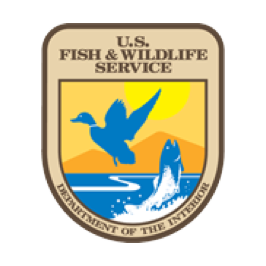Fall 2021 – From The Eagle’s Nest Newsletter
From the Eagle’s Nest
Fall 2021
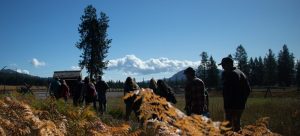
Attendees at the National Conference visited the Kalispel Tribe Indian Creek Community Forest. Photo courtesy of Ryan Comfort.
Featured Articles
Message from the President
Message from the Executive Director
38th Annual National Conference
Great Lakes Regional
Regional Scholarship Winners
A Day in the Life of a CLEO
NAFWS Chronic Wasting Disease Program
NAFWS Awarded Alaska Tribal Climate Resilience Grant
Navajo Youth Hunt
NAFWS Education Update
Conservation Law Enforcement Update
NAFWS Welcomes New Team Members
Invasive Species, Wildlife Disease, and Endangered Species – Fish & Wildlife Updates
Message from the President
Elveda Martinez
It’s raining! The rain is so welcomed here in the desert. We’ll take any moisture that we can get. After the hottest summer on record and with the upstream reservoirs with limited water I can say our prayers were answered.
I hope all that attended the national conference in Spokane, Washington enjoyed themselves and learned something new whether in one of the pre-conference sessions, during the general sessions or in a break-out. I’d like to say “thank you” to the Kalispel Tribe of Indians for being our host tribe. It’s always good to visit different parts of the country and meet new people. I was not able to attend this year’s conference but was involved with the planning team and happy that our Society was welcomed to Kalispel country. This year’s conference was sponsored by the Pacific Region, and we appreciate the board members who worked hard to make sure this conference had a regional and national flair – thanks to Donna Nez and Laurel James for being great representatives to your region. Alternate Ted Lamebull was also there to represent the region and help with conference tasks. The memorial slide show was a highlight – I have to say “thank you” to those that made great impacts in Indian Country over their lifetimes.
I am honored and humbled to say that I was again voted in as the President of the Society. I’ll be serving with Mike LaVoie, Vice-President and Mitzi Reed, Secretary/Treasurer for another term. With the dedicated staff and contractors that we have on board our Society is growing and moving forward. In the next few months, we will be adding staff due to receiving funding from the BIA, the PEW Charitable Trust and from the USFWS (waiting on). In late September we were notified of our grant approval through the Tribal Climate Resilience program; we’ll be hiring 3 FT and 1 graduate level intern in the Alaska Region. Julie our Executive Director has a done a great job in writing grants for the Society; we appreciate all who contribute to these efforts as well. There is more to come.
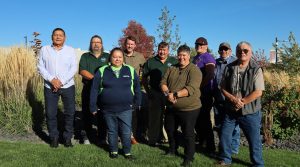
Board of directors at the 2021 National Conference from left to right, back row: Selso Villega (SW Alternate), Terry Metoxen (GL), Mike Lavoie (SE), Don Reiter (GL), Jeff Kelly (GP), Charles Wilkinson (GP), Ted Lamebull (PR Alternate), front row: Laurel James (PR), and Mitzi Reed (SE).
Our Board met on Sunday, October 3, 2021, prior to the conference. I’d like to thank the Board for taking the time to be a part of the Society and working to make sure that decisions are made for the betterment of our organization. Some highlights from our October 3, 2021, Board meeting that I attended via zoom:
- President’s report – I provide written reports to the Board and include updates on the Board dealings, financial, investment, Eagles Nest, Partnerships, Interns, Membership, RAWA, Wildlife Corridors, national conference, SW Regional Conference and miscellaneous issues.
- Consolidation of bank accounts – we have moved all our funding to the ANB in the Denver area for better accountability.
- Kaleidoscope Contract – SW Region water assessment – approved contract; BIA funding.
- Personnel Policy Amendment – add in bonus section approved by the Board.
- Investment Update with Indian Land Tenure Foundation – since we invested $300,000.00 in January of 2020, we are now up to $364,397.18; we’ve earned $64,397.18.
- Graduate Fellowship Program – staff and Dr. Shaun Grassel of Lower Brule are developing this program; it is a priority to continue to develop our youth and educational programs.
- RAWA – this legislation is gaining momentum in Congress; if it passes it will allow for tribes to share in $97.5 million for their fish, wildlife and conservation programs.
- Staff updates – all staff provided updates on their programs and goals for 2022.
All regions are getting ready to set their goals and objectives for 2022. If you have any ideas, please do contact your regional directors or Julie Thorstenson our Executive Director. We love to hear from our membership.
I pray that you all continue to stay safe and healthy. Continue to do great work for your Tribes, Fish and Wildlife.
Message from the Executive Director
Julie Thorstenson, PhD
Greetings Members, Partners and Friends! I am very excited to report on all the great things NAFWS has going on and in development. The last quarter has felt a bit more like “normal” for NAFWS’ operations with three in-person events.
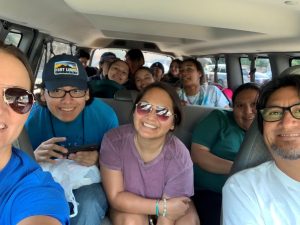
NAFWS’ staff, interns, and SYP students
The first in-person event was the National Native American Environmental Awareness Summer Youth Practicum (SYP) held July 25-31 at the YMCA of the Rockies in Estes, CO. Ashley Carlisle, Education Coordinator did a fantastic job in developing and delivering an educational and safe experience for everyone. I was able to attend for two days and interact with the students and NAFWS’ interns and staff. It was an amazing experience, and I came away so inspired by the students. For me the highlight was listening to every student introduce themselves to our presenters in their Native languages. Keep an eye out for these “future protectors, conservationists and leaders”. See the NAFWS Education Update below for more information on the 2021 SYP.
July was a good month for partnerships. We entered into a partnership with the Pew Charitable Trust to expand our staff with the addition of a Wildlife Connectivity Coordinator (WCC). The WCC will be responsible for providing technical service to the NAFWS members and member Tribes with an emphasis on ungulate migration conservation, primarily in the West.
We partnered with the U.S. Fish and Wildlife Service to host a listening session on the America Recovery Plan (ARP) sec. 6003 for 31 participants. This listening session will help guide the funding for Tribes under the ARP. We also continued our discussions with Martha Williams, FWS Principal Deputy Director on tribal fish and wildlife concerns.
Another highlight of July was the introduction of the Senate version of Recovering America’s Wildlife Act, Text – S.2372 – 117th Congress (2021-2022): Recovering America’s Wildlife Act of 2021 | Congress.gov | Library of Congress We continue to work on building the Tribal Coalition and educating on the importance of Recovering for Tribes as one of our 2021 National Initiatives. The Alliance and Tribal Coalition are working hard to support Recovering in the 117th Congress. Continued bipartisan support for Recovering is very important for Tribes to finally see dedicated, annual, sustainable funding. If you are interested in joining the Tribal Coalition, please contact me.
We continue to adapt our services and events around the Pandemic and in August we hosted our first ever virtual Regional Conference for the Southwest. While nothing can completely replace the in-person interaction, the Southwest Regional Conference provided up to date important information on regional and national issues affecting Tribal fish and wildlife management.
Through our work on policy and advocacy for Tribal fish and wildlife management we have discovered a gap in our ability to tell the complete accurate status of fish and wildlife management in Indian Country. This puts us at a disadvantage to our state and federal counterparts. NAFWS developed a short, anonymous Tribal Fish and Wildlife Management survey and distributed to every Tribal fish and wildlife/natural resource contact we had in the lower 48 states on August 4, 2021. To date we have 80 responses and hope to have a minimum of 100 when we compile the report in December. If you have not completed or received the survey, please contact me for the link. YOUR INPUT IS NEEDED.
September centered largely around conferences. The staff continued to work on National Conference planning as well as assisting and attending the Great Lakes Regional Conference. The 34th Annual Great Lakes Regional Conference was held September 19-23 in Manistee, Michigan hosted by the Little River Band of Ottawa Indians. Although many things were different than past conferences, the commitment to tribal fish and wildlife management was still very present. I want to thank all the Great Lakes planning and host committee for a wonderful conference.
I am very lucky to have a strong team at NAFWS; in September we welcomed April Richards to our team as NAFWS’ Public Information Officer. April hit the ground running with awesome coverage of the Great Lakes Regional Conference. See new staff.
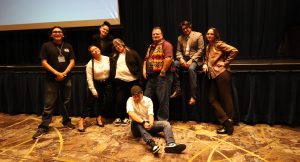
Samuel Chischilly, Ashley Carlisle, April Richards, Heidi McCann, Mathis Quintana, Sean Cross, Robert Romero, Julie Thorstenson. Photo courtesy of Jill Feldhusen.
We are very excited to announce NAFWS was awarded the Tribal Climate Resilience Grant for the Alaska Region. We look forward to working with Alaska Natives and building our capacity with the addition of 3 full time positions and one intern. This also helps serve NAFWS’s 2021 Initiative of Climate Change.
Despite the continued concerns and setbacks of the Pandemic, I remain optimistic that we will get to a place of “normalcy”. We continue to seek ways to better serve you, our membership, through our mission to assist Native American and Alaska Native Tribes with the conservation, protection, and enhancement of their fish and wildlife resources. As always, if you have ideas for the NAFWS, please contact me or your regional director(s).
Pilamaye ye,
Julie Thorstenson, PhD
Executive Director
38th Annual National Conference

Keynote speakers from the CTUIR Youth Leadership Council Bryson Spino, Keyen Singer, and Latis Nowland (Left). Sean Cross teaching the CWD workshop (Right).
The 2021 Annual National Conference was hosted by the Kalispel Tribe of Indians at the Northern Quest Casino & Resort in Spokane, Washington on October 4-7, 2021. Francis Cullooyah, Kalispel Cultural Director, inspired the theme of this year’s conference when he said, “We were never self-sufficient, we have always been collaboratively sufficient.” This theme, Collaborative Sufficiency, emerged again and again as presenters and attendees discussed the need to form collaborations and celebrated existing ones.
Despite COVID and travel restrictions, 120 people from all seven NAFWS regions attended the conference. Attendees enjoyed workshops, natural resource tours, presentations, a traditional feast and more.
Keynote Address: Our keynote address was delivered by Keyen Singer, Latis Nowland, and Bryson Spino of the Confederated Tribes of the Umatilla Indian Reservation (CTUIR) Youth Leadership Council. These students, accompanied by their advisor Julie Taylor and Keyen’s mother, fisherwoman Cara Greene, shared their efforts to aid salmon recovery. The students wrote a letter to President Biden and started a petition to remove dams on the Snake River that threaten salmon populations by inundating spawning areas and raising water temperatures. Sign their petition.
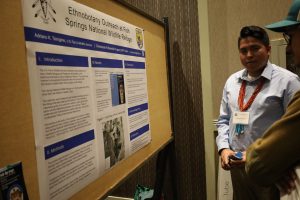
Adriano Tsinigine is a 2021 NAFWS Southwest Region scholarship recipient. He presented in our Student Poster Session winning 2nd place.
Student highlights: Twelve college students including NAFWS interns, students from Oregon State University’s New Beginnings for Tribal Students (NBTS) program, and student presenters attended the conference. NAFWS hosted our first Student Poster Session providing an opportunity for students to share their research and network with conservation professionals.
CLEO Highlights: Conservation Law Enforcement Officers (CLEOs) attended workshops, presentations, and competed in the 2021 National Shoot Competition. Kenny Oldfield and Ruby Morning from Alabama Fire College, long-time NAFWS partner and conference sponsor, hosted a workshop on Hazardous Materials Awareness and Matt Quinn of the Great Lakes Drone Company familiarized officers with drones and aerial regulations.
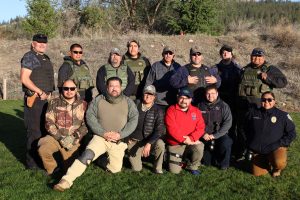
Conservation officers competed for the National Shoot Competition. Three teams competed representing the Great Lakes, Great Plains, and a combined Southwest team.
The National Shoot Competition faced a hurdle when travel restrictions left teams without enough shooters to compete. However, keeping with the conference theme of Collaborative Sufficiency, shooters voted to allow a combined team of Southwest, Pacific and Great Plains shooters to represent the Southwest region. The combined team of Zachary Ashkie (SW), Jerrel Wilson (SW), Charles Wilkinson (GP), Jeremiah Dude (SW) and Alexandria Thompson (PR) won the competition. Zachary Ashkie took home the Top Shooter Award with a 96% hit rate. Thank you to Officer Jessie Aston, Kalispel Tribal Police Department; Special Agent Scott Winkler, USFWS/OLE; and Special Agent Richard Bare, USFWS/OLE for assisting with the shoot competition.
National Awards: Each year NAFWS presents national awards including the Chief Sealth Award, Biologist of the Year, and Conservation Officer of the Year. The 2021 recipient of the Chief Sealth Award was Robert Sanders, Wildlife Division Manager for the Little River Band of Ottawa Indians. The Biologist of the Year award went to Eric Clark, Lead Wildlife Biologist for the Sault Ste. Marie Tribe of Chippewa Indians. Conservation officer Thomas Jones of the Fort Belknap Indian Reservation was awarded Conservation Officer of the Year.
Election Results: Elveda Martinez of the Walker River Paiute Tribe was re-elected NAFWS President and Donna Nez of the Confederated Tribes of Umatilla Indian Reservation Department of Natural Resources, was re-elected Pacific Region Director.
Great Lakes Regional
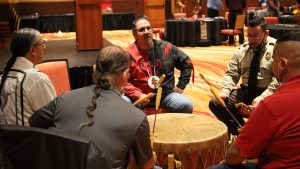
The Thunder Bear singers perform opening ceremonies for the Great Lakes Regional.
The Great Lakes Regional Conference, hosted by Little River Band of Ottawa Indians at the Little River Casino Resort, took place September 19-23, 2021. Our Great Lakes Regional Directors, Don Reiter and Terry Metoxen, organized the conference. Seventy people from 23 Tribes, attended the event and enjoyed presentations, workshops, and tours. Former Chairman of the Little Traverse Bay Band of Odawa, Frank Ettawageshik, inspired listeners with his keynote address as he spoke of Anishanabee cultural practices, traditional knowledge, and the importance of Indigenous voices in natural resource management.
Event Highlights: NAFWS Fish and Wildlife Biologist Corey Lucero taught a Chronic Wasting Disease (CWD) workshop to biologists and conservation officers. Participants learned to remove the lymph nodes and obex used to test for the contagious disease that impacts deer, elk, and moose populations.

Corey Lucero and Ashley Carlisle prepare to release sturgeon from the Little River Band Sturgeon Streamside Facility.
Sturgeon Streamside Facility Tour and Release: – Attendees toured the Little River Band Sturgeon Streamside Facility and had the opportunity to release sturgeon into the Manistee River at Rainbow Bend. The facility has released 406 sturgeon in 2021 so far!
CLEO Highlights: Conservation officers had a busy week with trainings in use of force, search and seizure, drone familiarization, and chronic wasting disease. Officers also competed in the Great Lakes Regional Shoot competition. Brad Cameron won Top Gun and he will be joined by Tim Mallory, Terry Metoxen, Don Carrick, and Ryan Gautheir to represent the Great Lakes at the 2022 National Shoot Competition. Ashley Zurn will be the first alternate.
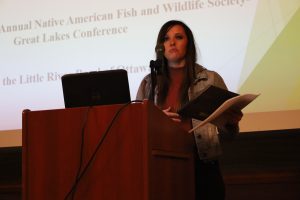
Ashley Zurn received the Conservation Officer of the Year Award.
Awards: Fish & Wildlife Technician with Grand Portage Band of Lake Superior Chippewa, Roger (Poe) Deschamps, Jr. was awarded Fish & Wildlife Technician of the Year. The 2021 Great Lakes Conservation of the Year award was presented to Ashley Zurn, White Earth Tribal Conservation Officer. Ashley and her partner Richard Fox, Jr. were instrumental in the arrest and prosecution of a man involved in the killing of a former Lake Park police officer. She dedicated her award to her late partner who passed in the summer of 2019.
Elections: Terry Metoxen, Conservation Officer, Oneida Nation, was re-elected as the NAFWS Great Lakes Regional Director to serve another two-year term.
Regional Scholarship Winners
Pacific Region Scholarship recipient, Reese Shippentower is a student at Oregon State University studying fisheries and wildlife science and a member of the Confederated Tribes of the Umatilla Indian Reservations (CTUIR).
Great Lakes Region Scholarship recipient, Molly Thomas is a student at Lake Superior State University studying conservation biology and a member of the Sault Ste Marie Tribe of Chippewa Indians.
A Day in the Life of a CLEO
Mathis Quintana, NAFWS CLEO Intern
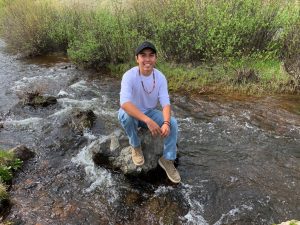
Mathis Quintana, CLEO intern for NAFWS.
Daanzho Mathis Quintana shi zhii. Shi ma Cherrise Quintana mizhi ashi shi Ka’ee Byron Quintana mizhi. Hello, my name is Mathis Quintana I am the CLEO intern for NAFWS. I am Jicarilla Apache and am from Dulce, New Mexico. I am a senior at Colorado State University majoring in Natural Resource Management with a minor in linguistics.
On Wednesday, August 18th, 2021, I did a ride along on my reservation with Korwin Atole, Chief Game Warden for the Jicarilla Apache Game and Fish. Korwin taught me about the responsibilities of a conservation officer, shared stories of his experiences working in the law enforcement field and provided advice as he took me to areas of the reservation I had never gone before. Our reservation is big, and it takes a lot of people working together to preserve and protect its natural resources.
There is a lot going on in different areas whether it be with the CLEOS, fisheries, or wildlife biology. I am proud that I come from the Jicarilla Apache Nation. I am grateful for this opportunity and would like to thank Korwin Atole and the Jicarilla Apache Game and Fish for allowing me this opportunity. Iheedn.
NAFWS Chronic Wasting Disease Program
Corey Lucero, NAFWS Fish & Wildlife Biologist
Chronic wasting disease (CWD) is a prion disease that affects deer, elk, reindeer, sika deer and moose. It has been found in some areas of North America, including Canada and the United States, Norway and South Korea. It may take over a year before an infected animal develops symptoms, which can include drastic weight loss (wasting), stumbling, listlessness and other neurologic symptoms. CWD can affect animals of all ages and some infected animals may die without ever developing the disease. CWD is fatal to animals and there are no treatments or vaccines. In areas where CWD is known to be present, CDC recommends that hunters strongly consider having those animals tested before eating the meat (CDC/CWD).
With BIA funding, the Native American Fish & Wildlife Society has been accepting applications for the Chronic Wasting Disease Project. Currently, 19 tribes from the Southeast, Southwest, Great Lakes, Great Plains and Pacific Northwest Regions are participating. The collection of 10 samples per tribe from cervid species is ongoing throughout 2021. CWD sampling boxes containing extraction equipment such as scalpels, forceps, specimen boxes etc. for those first 19 tribes have been shipped or delivered. If your tribe would like to participate, there are spots still open, contact Corey Lucero.
Learn more about CWD and the NAFWS CWD project
NAFWS Awarded Alaska Tribal Climate Resilience Grant
On September 21, 2021, the Bureau of Indian Affairs announced awardees for the Tribal Climate Resilience Program. The program will fund 79 Tribes and 13 Tribal organizations a total of $13.84 million. NAFWS was awarded the Alaska Tribal Climate Resilience Grant to fund three Alaska Regional Tribal Climate Resilience Liaisons (TCRL) and one Alaska Native college intern. NAFWS’s goals include:
- Increase capacity for intragovernmental coordination regarding climate science and adaptation needs
- Support and training on climate adaptation planning and implementation
- Enhance information exchange through building and implementing the Alaska Tribal Resilience Learning Network
- Development of science and tools to meet tribal needs, and;
- Develop and support the next generation of tribal climate experts through our education program and the hiring of an Alaska Native student intern.
The Senior Tribal Climate Resilience Liaison position is currently open.
Navajo Youth Hunt
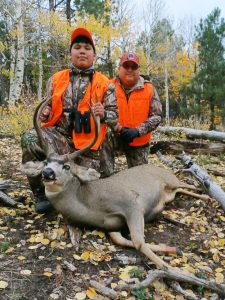
Young hunter and his mentor harvest his first mule deer.
In 2005, Conservation Officer Eddie Benally, founded the Navajo Nation Annual Youth Hunt following a conversation with a young boy who expressed a desire to hunt, but had no one to teach him. Every year since, the Navajo Nation Department of Fish and Wildlife has sponsored a hunt for youth 12-16 years old to teach them the basics of hunting and outdoorsmanship. Eddie passed in January of 2021, but his legacy lives on with these young hunters.
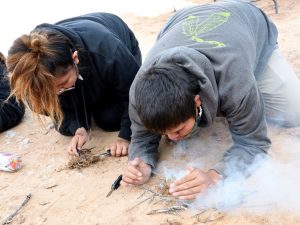
Students learn to make fire.
Following the cancellation of the 2020 hunt due to COVID, a scaled-down hunt took place October 8-10, 2021. Eight students participated in the 3-day hunt after training in hunters’ safety, wildlife identification, wilderness survival, navigation, and gun safety. Event sponsors provided young hunters with all the necessary equipment for a successful hunt and mentors, biologists, and state agency representatives taught natural resource education classes and guided students through the hunt. All eight hunters successfully harvested their first mule deer. Thank you, U.S. Forest Service and all sponsors for supporting this project.
NAFWS Education Update
Ashley Carlisle, Education Coordinator

2021 National SYP in Estes Park, CO – SYP students, NAFWS staff and interns.
Summer has come and gone, and the Colorado landscape is altering from green to vibrant orange and yellows. NAFWS has been busy by continuing to hold annual programs such as the National Summer Youth Program (SYP) and starting new programs and events such as our internship program and poster session event at the National Conference.
The 2021 National SYP was a fun learning experience for our staff, interns and our nine SYP students. Our week consisted of students hearing from our previous Education Coordinator, Sally Carufel Williams, NAFWS Staff and guest speakers from the Native American Rights Fund, USDA APHIS, US Fish & Wildlife Service, and Greenwood Wildlife Rehabilitation Center. Students were able to visit the headquarters of Trees, Water, People, Colorado State Forest Service Nursery and Colorado State University campus. If you want to learn more details about the 2021 National SYP, you can view the 2021 National SYP Final Report on our website.
Our intern’s last day was on October 15. Mathis, Jovon, Samuel and Tamra have all worked hard through their internship since it began in June! They accomplished a lot in the span of their time with us:
- Completed group projects that were successfully presented at the National Summer Youth Practicum (SYP), one of those included implementing a scenario exercise for the whole morning of our last day at the SYP
- Served as counselors at the SYP and as helpers in planning, setting, and cleaning up
- Collected contact information data from Tribes within the lower 48 US states to better NAFWS’ outreach and engagement
- Started the process of the Fish & Wildlife Surveys, Conservation Law Enforcement Officers (CLEO) Surveys and Fisheries Surveys to help in gaining baseline data so that NAFWS can better understand how to help tribes and regions regarding their fish, wildlife, natural resources, and CLEO programs/departments
- Presenting on their experiences at the SYP, and on their projects/internship at the Southwest Regional Virtual Conference and at the National Conference in Spokane, WA
- Provided feedback to help us shape and improve our internship program and Summer Youth Practicum (SYP)
Overall, it was such a blessing to be able to watch them grow throughout their time with us, see their passion and witness their serving hand and hearts. We will continue to pray for them and offer support, guidance, and encouragement as they continue in their educational and personal endeavors.
We are happy to have had a successful first National Tribal Poster Session and Professional Mixer at our 2021 National Conference in Spokane, Washington. We had a total of six research posters, five were presented by students and one was presented by a wildlife professional from Colville Confederated Tribes. The projects showcased and shared covered a variety of topics including forest management, lynx management proposal, ethnobotany outreach, invasive squirrel disease, fisheries surveys, and conservation law enforcement. As part of the poster session, NAFWS had three judges to provide feedback to students regarding their poster and presentation of their poster as well as making the hard decision of 1st, 2nd, and 3rd place poster winners. The awards were announced at the National Conference banquet, Mr. Luis Lopez-Contreras won 1st with his poster on the Flora of the Malheur National Forest. Followed closely by Adriano Tsinigine (2nd) and Deandra Jones (3rd).

Awards for the first National Tribal Poster Session. Left to Right, Dr. Julie Thorstenson, Luis Lopez Contreras, Adriano Tsinigine, Deandra Jones, Samuel Chischilly, Mathis Quintana, and Ashley Carlisle.
Conservation Law Enforcement Update
Robert Romero, CLEO Consultant
Hello everyone. It’s been a busy quarter for all our staff as we pushed forward with planning and implementing several in-person and virtual based events and conferences. Unfortunately, we still hit some bumps in the road as a result of the pandemic, but we’ll continue to press on in hopes of providing in-person CLEO training in 2022.
In July, I was able to present at and support the 2021 Summer Youth Practicum in Estes Park, CO. (See education update) It was a very rewarding week spent with staff and the outstanding group of our future conservationists and environmentalists!
In August, NAFWS supported the Southwest Regional Conference, which was hosted virtually from August 10-12, 2021. CLEO sessions were presented by U.S. Fish and Wildlife Service/Office of Law Enforcement (FWS/OLE) Special Agents assigned to duty stations located in Arizona and New Mexico, and included the following topics:
- FWS/OLE overview with priority levels of investigation and structure of regional personnel
- Lacey Act history and application in Indian Country
- Evidence collection, security and chain of custody
- FWS/OLE case review of pertinent southwest investigation
We had been planning with representatives from the Great Plains Region and the FWS/OLE in the Rocky Mountain states to host a 40-hour CLEO training in Billings, MT the week of August 30-September 3, 2021; however, that training was postponed to June 2022 based on several influences of the Covid pandemic.
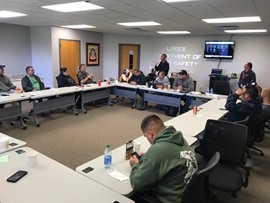
Matt Quinn, Great Lakes Drone Company. Photo courtesy of Robert Romero
Despite this setback, the NAFWS staff supported the Great Lakes Regional Conference from September 20-24, 2021. Although we planned for in-person guest speakers, we had to move to a virtual platform for the CLEO sessions provided by the Federal Law Enforcement Training Center who presented training on Use of Force, Search and Seizure, Surveillance and Resilience. The Great Lakes Drone Company was able to attend and provided in-person instruction on the Familiarization, Requirements and Use of Unmanned Aircraft Systems (Drones).
Additionally, the Great Lakes Region held a practical pistol competition for their officers to compete to establish their regional team that will compete in the 2022 National Conference shoot. Congratulations to the Top Gun, Bay Mills Indian Community Officer Brad Cameron, and to all the other officers who finished in the top 10 positions!

GLRC Practical Pistol Competition
We successfully planned and executed the 2021 NAFWS National Conference in Spokane, WA the week of October 4-7, 2021. This was a huge undertaking for a new staff, but in the end, we did it with the support of many! Stay tuned. More details will be forthcoming in the next Eagle’s Nest Newsletter.
Lastly, I continue to identify CLEO managers/supervisors for all applicable tribes to solicit information directed at specific needs of Tribal CLEO Programs through an anonymous survey. All data collected will be used internally only to justify funding needs to support those programs on a national level.
Join NAFWS to receive training support as an individual member or member tribe, and as always, if you have any CLEO training concerns, suggestions, or needs please send me an email using the “Contact” link on our webpage.
Take care and stay safe!
NAFWS Welcomes New Team Members
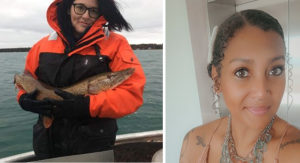
New team members April Richards and Deb Anyaibe.
In September, April Richards (left) joined the NAFWS staff as our Public Information Officer. April received a Master of Science degree from the University of Michigan in conservation ecology and environmental justice with a focus in fisheries and aquatic ecosystems. While in Michigan, she worked with the Little Traverse Bay Bands of Odawa to support native fish restoration in the 1836 Treaty Waters of Lake Michigan. Following graduate school, April worked in southeastern Florida assessing toxin transfer from harmful algal blooms to subsistence fishing communities. Prior to joining our staff, April worked with commercial fishers in the Gulf of Mexico to collect data on fishing efforts and protected species interactions.
Most recently, NAFWS contracted Deb Anyaibe (right), owner of Kaleidoscope Consulting, to assist with assessing the state of Wildlife Water Resources in the Southwest Region. Deb has over 10 years of experience in the environmental field and previously worked for the Pueblo of Zia and Pueblo of Laguna in New Mexico. She has a master’s degree in Hydrology as well as a master’s degree in Environmental and Natural Resource Planning. She has extensive experience in water resource assessment and is very excited to be assisting NAFWS. The project she is assisting with will include contacting tribes and Pueblos in the southwest region to assess the current state of the wildlife water resources and determine several shovel ready projects in the region. For those in the southwest, Deb will be reaching out to you in the coming weeks so please prepare so that this project can be done completely and efficiently. Thank you!
Invasive Species, Wildlife Disease, and Endangered Species – Fish & Wildlife Updates
Invasion Alert!!! Spotted Lanternfly
Sean Cross, NAFWS Fish & Wildlife Biologist
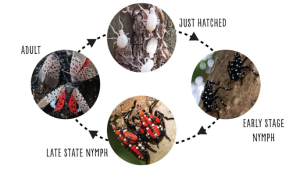
Life cycle of the spotted lanternfly. Image courtesy of USDS APHIS.
The spotted lanternfly (Lycorma delicatula) is a two-inch exotic Fulgorid type insect from China and Southeast Asia, it is a bark sucker and can do tremendous damage to smooth barked woody plants. If allowed to spread in the United States, this pest could seriously impact the country’s grape, orchard, and logging industries, and there are indications that other native plants may be at risk.
With their wings outspread, the spotted lanternfly could be mistaken for a colorful butterfly or moth, but they are a species of planthopper. The adult spotted lanternfly has two sets of wings, the underwing is divided into two color patterns, the inner portion is a very distinct red color with black spots while the outer portion sports a black and white stripe pattern. The outer wings are white and covered in black spots that alter into scale like markings in the last 1/3 tip of the wing. Adults have piercing, sucking mouthparts and weaken the plants through feeding on them, which can make it difficult for the plant to survive the winter months. Congregating spotted lanternfly insects produce a sticky substance that has a fermented odor called “honeydew” in large quantities that over time becomes infested with sooty mold that attracts other pests in the area.
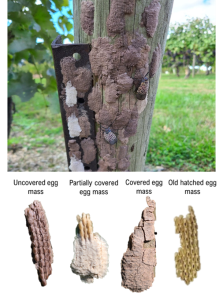
Lantern fly egg masses. Image courtesy of USDA APHIS.
The spotted lanternfly (Lycorma delicatula) was first detected in Pennsylvania in September 2014 and even after intensive control measures, this pest has spread outward to other parts of the Eastern United States. Spotted lanternfly populations are currently found in 11 states including: Connecticut, Delaware, Indiana, Maryland, Massachusetts, New Jersey, New York, Ohio, Pennsylvania, Virginia, and West Virginia. Spotted lanternfly does not fly long distances, but it is a problematic hitchhiker and is often spread unknowingly by humans. Starting in the fall, females seek out outdoor surfaces and lay mud-like egg masses on tree bark, cargo (nursery stock, lumber, etc.), outdoor gear (such as lawnmowers, bikes, and grills), vehicles, trailers, and more.
How to stop the spread
Anyone receiving goods from the east coast should inspect for signs of the insect, especially if the commodity is to be kept outdoors. If you find this pest outside of a spotted lanternfly quarantine area, please take a picture of it and note the location to report it to your local Department of Agriculture or Fish and Wildlife Agency before killing it. For more information contact NAFWS staff or visit the USGS and USDA APHIS websites.
Elk Hoof Disease – New Findings
September 16, 2021 – Elk Hoof Disease, or Treponeme-associated hoof disease (TAHD), is a bacterial-associated syndrome that causes deformed, broken, or missing hooves in elk resulting in severe lameness and often death.
The Elk Hoof Disease Research Team at Washington State University discovered one way even healthy elk can contract the disease, walking on soil contaminated by infected hooves.
Read the full WSU press release here.
Black-Footed Ferret Reintroduced to Standing Rock Sioux Tribal Lands
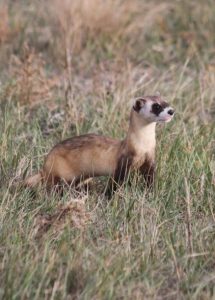
Black-footed ferret reintroduced to Standing Rock Reservation. Photo courtesy of Dr. Michael Gutzmer.
Wednesday, October 20, 2021, in McIntosh, SD, Standing Rock Sioux Tribe Game & Fish Department in collaboration with the U.S. Fish and Wildlife Service (USFWS) released 28 endangered black-footed ferrets on their reservation lands in South Dakota.
Read the full article by Dr. Michael Gutzmer, Standing Rock Sioux Tribe Wildlife Biologist.




